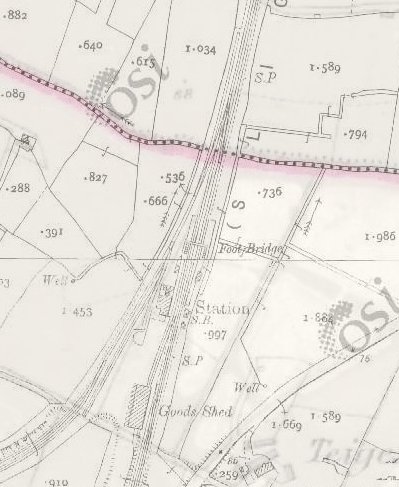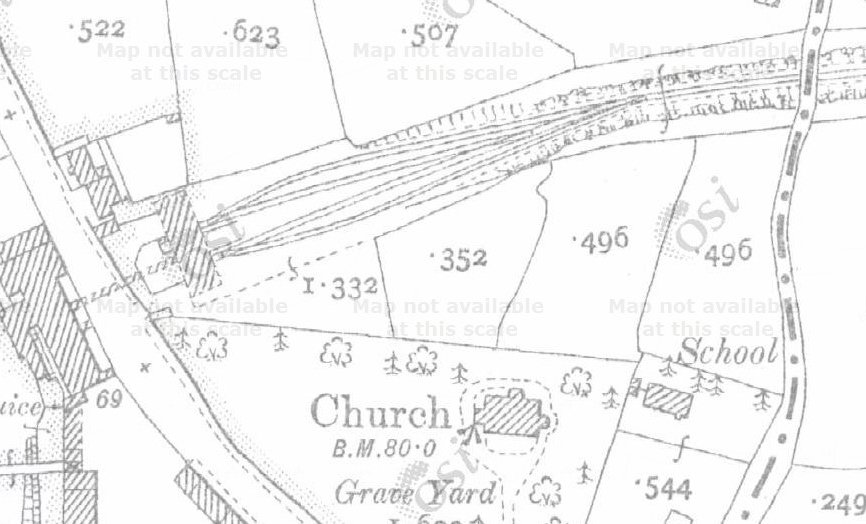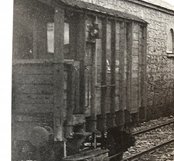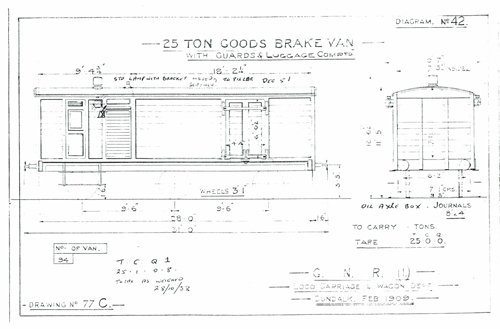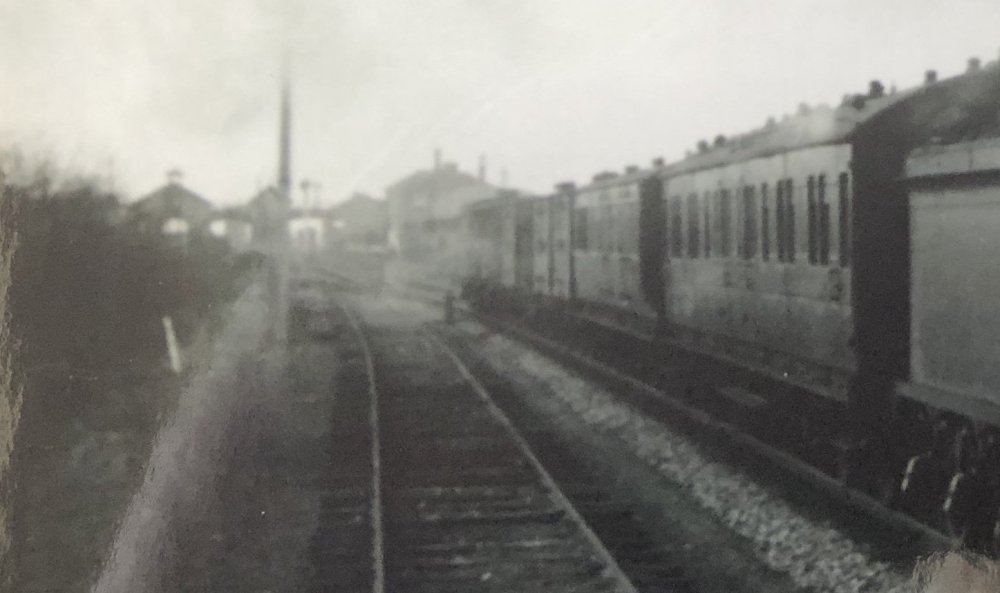-
Posts
4,855 -
Joined
-
Last visited
-
Days Won
119
Content Type
Profiles
Forums
Events
Gallery
Blogs
Store
Community Map
Everything posted by Mayner
-
Iain Rice and the late Bob Barlow modelled a 4mm Martello tower on their Orford Haven layout in the 1980s. As far as I recall the tower was turned from a piece of mahogany and modelled in a derelict condition with the lead partially stripped of the roof exposing the roof structure, the back story was that the tower was used as a lock up by Customs after the Napoleonic wars.
-
I might as well post a photo of the original 4mm version, I did not have a 5p or $0.20 coin handy when I took the photos, . Angus did very well to solder the tiny T strapping & door latches to the Meat/Fish Van, I struggled with them.
-
The 201 or J11 Class was basically a tank engine version of the J15 both classes shared the same boiler and motion and appear to have been considered the "maid of all work" in terms of GSWR tank engines. Bill McDonnell wrote about their work in the Cork Region in "In a Decade of Steam", although built as goods locos some incl 201, 207-209 were fitted with steam heating apparatus for working passenger trains. They were built as shunting and transfer locos and seem to have been mainly used on the Cork Area, including passenger trains between Cork and Bantry, in addition to shunting, trip working (Glanmire Rd-Albert Quay & the "run of goods" Glanmire Rd-Rathpeacon) and banking heavy goods trains from Cork through the tunnel to Rathpeacon Marshalling Yard. I haven't seen any mention of them working in the Dublin area.
-
I suggested a small shunting locomotive mainly because the majority of the shunting at Polloxfen's Mill would have taken place when a main line loco was not present. Operation at Polloxfen's appears to have been similar in principal to a sugar factory or coal mine with the main line loco dropping off and collecting cuts of wagons from the loops within the mill yard. Polloxfen's staff positioning individual wagons for loading/unloading at the loading platforms or bulk grain loading/unloading building. Traffic appears to have been heavy while the siding was in operation, the original layout with two loading banks and two sets of loops appears to have been expended to include 3 loading banks with three sets of loops and a siding or sidings to a bulk grain loading/unloading building visible with doors closed on left in photo in JHBs post. Bulk grain for Ballysodare appears to have been loaded at Ferns and possibly Enniscorthy on the South Eastern and from Dublin Port, traffic was carried in a mixture of CIE and GSR built hopper wagons in CIE days, a number of CIE hoppers including some converted from H Vans are visible in a photo of the mill sidings in JHB & Barry Carse's Rails Through The West Wagons may have been moved around the yard by human or horse power possibly with gravity assistance,( possibly with a tractor or truck as a tug in later years.) when a main line locomotive was not available. Although the MGWR did not have anything exactly suitable or economic for light shunting at Ballysodare Mill the SLNCR had a pair of Hunslet contractors/industrial tanks Faugh-a-Ballagh and Waterford which were used for shunting an banking duties a couple of miles down the line at Collonney SLNCR. Given the space in interesting idea would be to use an industrial loco for shunting the mill sidings and working wagons up to the station for a main line locomotive to collect, the two long sidings off the Mill Branch before it connects with the main line almost appear to have been intended for this purpose. While a small shunting locomotive shunting would add to the operating interest and were commonly used on industrial siding in the UK and overseas, they were fairly uncommon in Ireland & Polloxfen's managed to operate its mill sidings without their own locomotive for many years.
-
Funnily enough I am looking at Ballysadare & Clara Mill siding as a corner industry on a 4mm layout, there an interesting series of the mill complex and the sidings around the turn of the 20th Century in the Lawrence Collection at the National Library. http://catalogue.nli.ie/Search/Results?lookfor=ballysadare&type=AllFields&filter[]=authorStr%3A"French%2C+Robert%2C+1841-1917+photographer"&filter[]=format%3A"Photo"&page=2&view=list Polloxfens Mill would make a spectacular model in its own right with the river running through the middle of the complex, various ropeways and conveyors to transport the raw material and finished product around the mill and the almost Wild West style conveyor head house above the railway sidings. Clara Mill does not have the appeal of Ballysodare but more practical as a background corner industry with a very simple track layout and towering grain elevators with plenty of corrugated iron. Loading/unloading wagons at Ballysadare would have involved a lot of shunting as only one wagon at a time could be positioned on the loading bank/head house sidings. Each siding was served by a loop presumably operated in a similar manner to a colliery with empties on one leg of the loop and full wagons on the other. Polloxfens do not appear to have had a shunting locomotive, though a small Hunslet like 299 or SLNCR Waterford would not look out of place. As David noted operation as a stand alone layout would be a bit one dimensional with H vans bringing out the finished product (feed, cereal or flour?) and bulk grain wagons bringing in grain from County Wexford or Dublin Port. I would not overestimate the number of wagons required for an Inglenook style shunting layout with 3 sidings and a headshunt. A loco and 5-6 wagons is more than adequate for such a layout with a head shunt long enough to take a loco and 5 wagons, more wagons and longer trains don't really add to the enjoyment of operating a shunting layout as it takes around the same amount of time to set out or pick up a single wagon as a cut of 3-4. I found that 24 wagons more than adequate for an operating layout with 4 yards/stations and could keep 2 train crews busy for several hours.
-
Its a MGWR goods brake dating from the 1870s most of which had disappeared following the arrival of the modern 20T vans like Galtemore's model in the early 1920s. The van retains wooden brakeblocks and may be in MGWR green, LGRP photo 7027 dated 18/7/31 of is No 29 at Broadstone in green livery with MGW lettering between the window and door at cill level & THIRD branding on the door. I built a 4mm model from known dimensions many years ago using plasticard and North West stripwood with plasticard cube rivet details, model checked out reasonably well against a drawing by Padraic O'Cuimin but I still need to repair the joint between the balcony end posts and the roof & replace those Kadee couplers with something more in keeping for an irish steam era model.
- 309 replies
-
- 5
-

-
- mgwr
- 21mm gauge
-
(and 1 more)
Tagged with:
-
Besides the Timoleague & Courtmacsharry brake 5J the CBSCR had a pair of "Covered Goods Vans with Guards Compartments" at least one of which 5B survived into the 1950. There is a photo of 5J & 5B in Ernie Shepherds CBSCR book although similar in general size and general arrangement to the County Down vans the West Cork vans appear shorter on Irish Standard wagon underframes and had differing side door and guards compartment arrangements. Both had outside framing with diagonal bracing, the CBSCR vans looked very much like a standard goods van with sliding doors and a guards compartment with duckets at one end while the Timoleague van had a more guards van appearance with full length footboards, double side opening doors and no guards ducket. The CBSCR also had some massive looking 6w 10T goods brake vans, with heavy outside framing similar to the standard Irish Covered Wagon, with a single guards door and ducket apparently at one end and no end windows. The BNCR/NCC goods brakes looked like a shortened version of the standard Northern Counties covered van with a balcony at one end though no duckets. There are photos and drawings of the Northern Counties vans in the May & Nov 2017 editions of New Irish Lines archive https://newirishlines.org/archive/. The Midland does not appear to have built road vans built some odd looking 20T 6 wheelers in 1912 with guards compartments with raised cupolas at each end and a drovers compartment in the middle. A diagram exists but I have not seen a photo of these odd looking vans.
-
Fairly ambitious to incorporate two junction stations close together in a relatively small space though the looped 8 arrangement adds to the length of run. An alternative might be to replace one of the stations with a fiddle yard and keep most of the "main line" hidden and focus more of the scenic branch line aspect. Brian McCann built a very nice N gauge model of Bagnallstown featuring the station, the Barrow and Thomastown viaducts mainly using converted rtr equipment in the 1970s, the layout was featured as Railway of the Month in the Feb 1980 Railway Worth while having a look for the article for its scenic treatment and modelling of the distinctive Bagnallstown station architecture. http://magazineexchange.co.uk/cw/railway-modeller-magazine-february-1980-issue.html
-
Hi Victor Its great to see the growing interest in the Midland, perhaps its getting to the stage for setting up a MGWR modelling circle or what American modellers call a Special Interest Group (SIG). My Grandfather (who passed away long before my time) was a Midland driver and have been collecting information/attempting to model the Midland over the past 40 years. I was mainly interested in modelling the CIE period but have been creeping backwards towards the 192s-30s, the complex MGWR liveries of the Victoria and Edwardian eras are far beyond my painting ability. While there is good coverage in terms of carriage and wagon drawings for the 1900-1905 period there is a serious gap in locomotive drawings for that period as the Broadstone locomotive general arrangement drawings appear to have been mislaid or destroyed and no diagram appears to exist of the 7-12 Class 2-4-0 mail engines of 1889-90 or of the K Class 2-4-0 of the 1890s in their as built condition with flyaway cab. Tim Cramer published a number of drawings on Midland Locos and 6 wheel coaching stock in GSR/CIE condition in his Irish Miscellany series in Model Railway Magazine during the 1970s, the late Padraic O'Cuimin one of the recognised authorities on the Midland published the Baronial Lines of the MGWR a history of the Loughrea & Ballinrobe Branches and a number of IRRS papers on MGW carriage and wagon stock, together with some large scale (but un-dimmensioned) locomotive and rolling stock drawings. Tim Cramer's drawings should be adequate for 4mm use and some of the coach drawing overlap with the MGWR general arrangement drawings in the IRRS compendium which are quite faded. A Beyer Peacock General Arrangement drawing for the D Class 2-4-0s of the 1880s exists in the library of the Manchester Museum of Technology and may be available to the public, I don't know if drawings are available from British museums of locomotives supplied to the Midland, by Avonside, Kitson or North British loco, but a builders photo of the B Class 0-6-0s of the early 1900s is available from the Glasgow Museum of Transport. In the past I have built models of MGWR locos in plasticard on modified rtr or my own chassis with reasonable results, but later turned to scratchbuilding in brass and eventually designing and producing my own kits. There are tutorials on assembling my kits in the JM Design section of the Manufacturers section of the News Group. The Ks 2-4-0 is sold out, but the etchings for the Horse Box & Meat/Fish Van are available to special order with some of the castings available from Dart Castings in the UK. The SSM convertible wagon is in whitemetal and builds into a nice model and is an essential for modelling the MGWR from the early 1890s onwards, SSM also produce a nice whitemetal model of the Irish Standard open wagon which were used by the MGWR from about 1918 onwards. Jeremy Suter produced very nice whitemetal models of the MGWR open box wagon and Standard Irish covered wagon used by the MGWR in its final years but the Jeremy Suter kits are rare but examples may appear occasionally on e-bay or exhibitions in the UK. Though expensive and with a long lead time Ultrascale https://www.ultrascale.uk/ are probably the best option for 21mm gauge locomotive and rolling stock wheel sets. The Ultrascale locomotive and rolling stock wheels are superior to similar driving and rolling stock wheels produced by their competitors and are available in P4 and EMF/fine OO profiles. The wheel centers are cast into the nickle silver wheel rims which both eliminates problems with steel wheel rims rusting and working loose, the wheels have a wide boss (contact area) with the axle which both ensures true running and reduces the risk of a wheel moving on its axle, the driving wheels also have a superior shouldered crank pin system. Alan Gibson wheels are reasonable but I have experienced problems with wheel rims coming adrift and having to Loctite the rim to the center, they have a steel tyre which is likely to rust if exposed to rust during chassis assembly and use 14Ba brass bolts as crankpins as I found the AG steel crankpins had a tendency to "wring" off when tightened. Gauges and axles are available through the Scalefour society store https://www.scalefour.org/stores/stores.html, Jeremy Suter may be able to assist if contacted through the S4 Society. Living in New Zealand when I use Gibson wheels I obtain 28mm axles from a local supplier.
- 309 replies
-
- 3
-

-

-
- mgwr
- 21mm gauge
-
(and 1 more)
Tagged with:
-
Its possible that the Newcastle Van may have been used to carry mails or parcel traffic. It looks suspiciously like a conversion of a standard GSWR 10T outside brake. It looks like there is a set of side doors in the luggage compartment, as the "door" panel appears to be proud of the main body framing and planking. The LSWR vans appear to have been set up with separate guards and goods compartments with a connecting doorway. Some of the LSWR road vans had single others had two balconies The GNR(I) built a pair of 25t 6 brakes with "Luggage Compartments" for the steeply graded Newry-Armagh and Keady lines.
-
One end converted to a van possibly for sundries traffic on a light traffic branch line. Purpose built "road vans" were used by the West Cork, NCC, SLNCR & T&C in Ireland and the LSWR in England, though they tended to look like a conventional goods van with a veranda or guards compartment at one end. Interestingly the guards steps and grab rails appear to have been removed from the "van" end of the converted ex-GSWR brake. Traditionally MGWR goods brakes included a drovers compartment and a cupola in the style of an American drovers caboose.
-
I imagine a repeat would depend on demand reaching or exceeding Kader's/Bachmann minimum quantity for a production run. Kader's minimum production run may be a lot higher than the factories that supply commissioners like IRM, Kernow and Hattons, as they tend to have focused in recent years on high volume production for the mainstream end of the American and UK market. While Murphy Models are likely to own the IP for the drawings & information supplied to Bachmann UK/Kader. Kader are likely to own the IP to the tooling as it is their design and are unlikely to agree to releasing the tooling to competitor to produce a small run of models. Kader retained the IP for models produced for Palitoy and Replica Railways iin the 70s & 80s which formed the core of the Bachmann Branchlines range in the 1990s. Some OEM models produced by Kader for commissioners like the E-R Models Baldwin Sharknose N & HO scale diesel have re-appeared in the Bachmann range when the original commissioner folded.
-
I love the snow scenes and the photos of the railway in operation, the approach to the station with the dense vegetation and bracket signal reminds me of Rathdrum. Building and maintaining a garden railway is a major challenge though very satisfying and I manage to run trains through most of the year. I find Autumn particularly challenging with leaf clearing a major weekly operation as there are large deciduous trees in our garden and and on our street.
-
Australian supermarket owner tells customer what to do with 5000 rolls of toilet paper and 150 packs of hand sanitiser after he asked for a refund Customer asked for a refund when e-bay refused to list the toilet rolls and hand sanitiser. I wonder did he pay the 20 people he got to do the shopping? https://www.nzherald.co.nz/world/news/article.cfm?c_id=2&objectid=12324944&&ref=recommended Our supermarkets restricted customers to two packs of packaged items each, only thing that has run out is flour with a lot more home cooking.
-
I think its likely to be later than 76, I think the Uniload containers for sundries traffic and Bedford TKs with tail lifts were introduced (on the Sligo & Wexford lines a year or two later. Luggage Van could be 2549-2558 Series 1960 or one of the later conversions from GSR Bredin coaches 2559-61----1971 or 2562-2591----1973 parcel traffic was serious business those days. I remember seeing an on line photo of the Athlone-Westport Night Mail at Roscommon made up of a 141 Class hauling a single luggage van, with a Renault R4 van picking up the mails, priceless if I could find it!
-
The Hornby Fowler 2-6-4T https://www.hattons.co.uk/10010/hornby_r2398_class_4p_2_6_4_42322_fowler_tank_in_br_black/stockdetail.aspx is pretty much the standard rtr donor for WT/jeep conversions. There are articles on Jeep conversions in the New Irish Lines Archive https://newirishlines.org/archive/. Colm Flannigan May 2004 & Nov 2006 editions. Richards Hobbs May 2017 edition. An etched body only kit designed to fit the Hornby chassis is available from Worsley Works, the kit does not include turned parts or castings and is only really suitable for modellers experienced in kit or scratchbuilding in metal.
-
Getting to see the light at the end of the tunnel, tender brake gear and final detailing. Another simple assembly jig to achieve some form of consistency in fitting the brake shoes to the hangers. Short piece of 0.45 wire drilled into block to pin shoe to hanger. One piece of 0.7mm to hold hanger in alignment & 2 short pieces of 0.7 to hold shoe in correct position while soldering. 3 sets of brake shoes and hangers and pull rods awaiting assembly. The pull rods were drilled 0.5mm before being removed from the fret. Assembled chassis. Although the kit is designed to use the SSM tender, I designed a new tender chassis to simplify weight transfer from the tender to the loco and beefed up the tender pull rods slightly to simplify assembly. The brake gear supplied with the SSM J15 is very fine and had experienced difficulty in assembling the brake gear on a loco several years ago. Assembling the kit to 21mm gauge with EMF profile wheels I was able to incorporate the distinctive double pull rod arrangement. Its best to omit the inner pull rods and fit the outer set to the tender body if you work in OO or use RP110 profile wheels. The brake gear is designed to be removable for painting and maintenance, with the hangers a push fit at the top with the bottom stretcher bar retaining the gear in position. Tender sub assemblies, the tender springs will be fitted after I have painted the tender. I drilled on spring 0.5mm as a template for drilling holes in the side of the tender, then use the original as a template for drilling the other springs, 0.45mm pins and axleboxes are retained with 100° low melting point solder. The large holes in the frame spacers arose as a result of an error in the tender CAD work. I went mad and modelled the tender brake shaft and linkages to the pull rods, barely visible in 4mm unless the loco and tender are uncoupled. LHS tender handrail and handbrake wheel to be straightened up. Tender tool boxes are from lost wax castings from a 3D printed original. Cab interior with splashers and reversing wheel fitted, cab floor and backhead to be tidied up when I complete mechanical installation. Valence and steps on fireman's side needs straightening. Posed portrait. Fairing between training bogie wheel and leading driver to be fabricated. Crankpins will be trimmed flush with nuts as part of final mechanical assembly
- 392 replies
-
- 10
-

-

-
Alkaline rather than acid basically a very large Nickel Zinc battery similar in principal to today's NiMH batteries https://en.wikipedia.org/wiki/Nickel–zinc_battery
-
Jeremy Clements wrote about his experiences in maintaining the locos and stock on the O Gauge Malahide Castle layout in the May 2011 edition of New Irish Lines https://www.dropbox.com/s/4xsw7iaya1qchkr/New Irish Lines - Vol. 6 No. 1 - 2011 May.pdf. It will be interesting to see how contemporary rtr locos and stock perform in similar conditions. The major risk is that replacements for parts that wear out like pick ups, transmission parts, motors and wheel sets are unlikely to be available once the manufacturers stock of spares from the initial production run sells out.
-

Cuisle na Tíre (“Ireland’s Transport Magazine”)
Mayner replied to jhb171achill's topic in General Chat
The most touching feature is the respect the magazine shows that the company still understood and valued the contribution of the individual who carry out humble but critical roles, it would be difficult to imagine a modern day public transport operator doing a similar feature on its staff in a public magazine. -
Here here! I just found out today that a very close relative in Ireland ended up in intensive care after he and his wife caught the dreaded virus, fortunately they both safely made it home.
-
I am inclined to agree with Edo that the photo is of an up train leaving Longford for Mullingar or Broadstone. The position and profiles of the loco shed, carriage shed and signal cabin were unique to Longford, "the churchspire" or blemish is likely to be the post of the down home signal. Longford engine shed had a high almost Spanish mission style cupola smoke vent, a carriage shed existed between the loco shed and down platform into GSR days which with the MGWR style footbridge would have created a twin arch effect. The train consist appears to have been fairly typical of Sligo line trains in GSR days with coaches followed by a string of non-passenger coaching stock possibly Meat or Fish Vans rather than horseboxes.
-
Having finished Aurora and 650 I though it was time to finally finish the test build of 52 Class GSWR No 1 starting with the loco brake assembly. 1st job was to drill out the pin holes 0.7mm for the brake hangers and 0.5mm for the brake shoes, despite the pin chucks struggled to grip an 0.5mm bit despite using the smallest size of collet, pin holders, I eventually used a thin slip of paper as a shim to secure the bit! The GSWR used an unusual double hanger arrangement on the 52 Class which was a bit of a challenge to design, Brake hangers as removed from fret on left, spacing washers folded over and brake shoe removed from hanger on right. Assembly jig using 0.7mm wire drilled through hanger into hardwood block, small drop of oil on wires to prevent soldering wires to hangers during assembly. Hole for 0.45mm wire for securing brake hanger drilled into hardwood block (do not oil wire!) brake shoe and second brake hanger threaded into position. Brake shoe soldered to hangers once correctly positioned and surplus o.45 wire trimmed off. I then removed one of the 0.7mm pins in turn before soldering the ends of the two brake hangers together, then cleared out the hole with a 0.7mm drill or a tapered broach. The brake stretcher bars and pull rods fitted together without a problem, there is sufficient space below the gear wheel when using a High Level Gearbox to bring the ends of the pull rod together below the brake cylinder position. I have not soldered the hangers to the top pivot wires as I prefer to assemble the brale gear as a separate sub assembly to allow the wheels and motor to be removed for maintenance or painting. I accidentally sent a superseded drawing to engraver which omitted the fairing that hides the leading sandbox and fills most of the space between the trailing bogie wheel and leading driver, I will form this part in the traditional way with a piercing saw and files of the test build. Despite a few anxious moments the loco brake gear fitted together without any problems, next stage is to assemble the tender brake gear and add complete detailing of the loco and tender before completing mechanical assembly.
- 392 replies
-
- 10
-

-

-
650 was No 13 Racer 655 was no 29 Clonsilla
-
My main workshop/railway room is in a converted 90 odd year old garage no doubt intended for the owners Model T or Bullnose Morris when our neighbourhood was first established. Although the timber framing and weatherboard was in good condition the building was leaning at an angle when we first moved in as the original foundation piles had rotted away. Several years later having leveled up and re-piled the building, lined and decorated the interior the conversion to a railway room is very much a work in progress, so far this year we have moved out most of my building and woodworking tools to a new workshop and I am planning to replace the existing roller shutter door with something more in keeping with the age and character of the building. Main work area with spray booth/paint shop in foreground and workbench in background. Large scale Loco roster/blackboard. I will remove the scroll saw to the general workshop eliminating the final source of wood dust from the railway workshop. The opposite aisle with the exhaust for the spray booth, traverser for future Irish layout on right. Main modelling workbench, modelling is done on an offcut of kitchen bench top in center, collection of soldering irons in foreground, Unimat set up as vertical drill in distance. Workbench has to be large enough for working on 1:20.3 scale locos & stock and assembling large scale track panels. Yellow storage bins mainly contain 4mm detail castings, & kit scratchbuilding parts. Looking toward the open doorway, jungle taking over outside! My version of the waiting/scrap lines at Inchacore works, the J15s are due to return to the works once I have completed three current projects. 9mm scale NZR loco in background. Opposite side of aisle to main work bench, large scale staging/fiddle yard on lowest level, live steam loco and N gauge layout sitting on baseboard for 4mm layout even more storage above!
.png.c363cdf5c3fb7955cd92a55eb6dbbae0.png)


